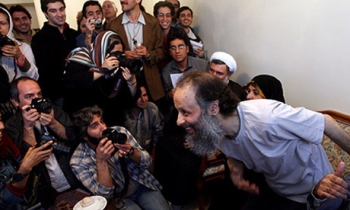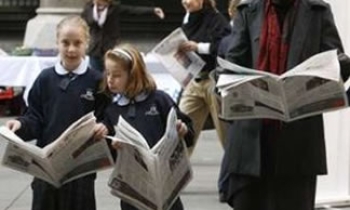Even if you're reading All the News That's Fit to Print on an ultra-mobile computer, it may soon look and feel the same way it does spread out with your morning coffee – minus the ink-stained fingers, perhaps.
Microsoft Chairman Bill Gates, appearing at the American Society of Newspaper Editors conference in Seattle, showed off a new feature of Microsoft's forthcoming Windows Vista operating system that promises improved "on-screen reading." He shared the podium Friday with Arthur Sulzberger Jr., publisher of The New York Times, which is partnering with Microsoft to develop a prototype application dubbed Times Reader. Microsoft plans to release development tools by the end of this summer for other newspapers and "whoever wanted to do these things," Gates said.
The newspaper industry has spent generations trying to make reading the daily paper a rich and engaging experience, and now it's transferring that journalism to the Internet, Sulzberger said.
"And quite frankly, we don't have the tools that we would like; we don't have the ability to make it a compelling reading experience as we ought to have," he said.
The new reader changes that, blending "the accessibility and the portability of print ... with the immediacy and interactivity of the Web," Sulzberger said.
It will automatically resize text, photos and advertisements to fit any size screen while maintaining a uniform design. That's a vast improvement over Web browsers, now the primary way people read news on the Internet.
"The Web surprisingly isn't taking advantage of what can be done in its environment," Gates said.
The reader is designed to better match fonts and other design elements with those in print so publications can maintain a distinct appearance across multiple formats. It offers easy ways to annotate text and its contents can be included in a desktop search.
It also allows readers to turn pages rather than scrolling, as demonstrated by Tom Bodkin, an assistant managing editor at The New York Times working on the project.
"The current Web technology makes it difficult to achieve the intimacy of a product you page through ... that has a sequence you can follow, a beginning and an end," he said.
Improving the way readers get digital content is important to the newspaper industry, which has seen print circulation decline during the past two decades, even as total readership has increased through the Web. Sulzberger said the industry has come to understand that it must be "platform-agnostic."
"We must follow our readers where they want to be," he said.
That will encourage readers to "spend more time with us," which in turn increases what newspapers can charge advertisers. Sulzberger said some kind of subscription model for the reader is also being considered.
Despite a growing emphasis at Microsoft on generating revenue through advertising, Gates assured the audience that "whatever your business model is in terms of advertising and content, or anything like that, we're not involved at all in that."
He added that the reader is "just an enabling tool" that will be a "fundamental feature" of the Vista operating system, due to be released to consumers early next year, which is also when the Times Reader launches.
"Vista in particular has been a huge investment, the biggest investment in a single piece of software ever," Gates said.
The proliferation of tablet and ultra-mobile PCs like the one Samsung is unveiling next week and widespread Internet connectivity will speed the transition from traditional to digital formats for a variety of content, including textbooks, he said.
"The fact that you can put something in your hands and subconsciously simply adjust your angle of viewing and your comfort ... makes a huge difference in terms of being willing to do long-term immersive reading off of a digital machine," Gates said.
An editor asked Gates how much an ultra-mobile PC would cost relative to a year's subscription to The New York Times.
Gates, the world's richest man, asked Sulzberger to remind him what a year's subscription costs.
The publisher's reply: "If you have to ask, you can't afford it."
Benjamin J. Romano: 206-464-2149 or bromano@seattletimes.com









